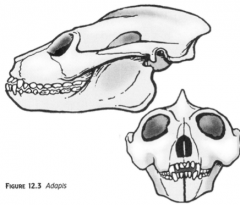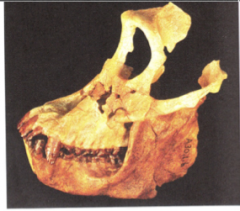![]()
![]()
![]()
Use LEFT and RIGHT arrow keys to navigate between flashcards;
Use UP and DOWN arrow keys to flip the card;
H to show hint;
A reads text to speech;
31 Cards in this Set
- Front
- Back
|
Earliest know primates were from? |
North America, 66 mya, Paleocene |
|
|
Earliest known primates? |
Plesiadapiformes |
|
|
Characteristics of Plesiadapiforms: |
- About 75 species - some diurnal, noturnal, size from small mouse to medium sized house cat - probably retained many primitive mammalian traits |
|
|
Two examples of Plesiadapiformes? |
- Purgatorius - Plesiadapis
ex: tree shrew |
|
|
Where were the "True" primates of the Eocene Epoch from? |
Present in North America, Europe, Asia, and Africa; 56-34 mya |
|
|
Characteristics of Adapoids:
|
- 80 different species
- Size: large rat to large housecat - Probably gave rise to strepsirhines (lemurs & lorises) |
|
|
Two examples of Eocene primates? |
- Adapoidae - Omomyoidea
Located in N. America & Europe |
|
|
Three genera of Adapoids |
- Cantius: N. America & Europe - Notharctus: N. America - Adapis: Europe |
|

|
Adapis |
|
|
Omomyoids Characteristics |
- similar appearance to the modern tarsier - most from Europe and N. America - shared common ancestor of tarsiers, monkeys and apes |
|
|
Three genera of Omomyoids |
- Necrolemur: Europe - Tetonius: N. America - Rooneyia: N. America |
|

|
Necrolemur |
|
|
Eocene primates in Africa and Asia
|
- Amphipithecus: Asia
- Pondaungia: Asia - Catopithecus: Africa - Eosimias: China - Darwinus Masillae |
|
|
Two types of Oligocene primates: |
- Parapithecidae - Propliopithecidae |
|
|
Oligocene Epoch |
Climate fluctuations affected primate ranges, 32-24 mya |
|
|
Type of Parapithecidae |
Apidium |
|
|
Apidium Characteristics |
- some similarities to new world monkeys - about the size of a squirrel monkey - might be the ancestor of platyrrhines and catarrhines |
|
|
Type of Parapithecidae |
Aegyptopithecus |
|
|
Aegyptopithecus Characteristics |
- probably an early catarrhine - possible ancestor to both old world monkeys and apes - teeth are comparable to those of hominids; Y5 molars |
|
|
Miocene Epoch |
- the cooling reversed temporarily and warmer temperatures were experienced for a time - tectonic activity, pushing the Himalayas upward - 24-5 mya |
|
|
Miocene Hominoid Characteristics |
- primarily arboreal - ape-like heads - body was a mixture of ape-like & monkey-like features - modern hominids, no tail - about 30 genera |
|
|
Miocene Hominid: African Form |
Proconsul |
|
|
Proconsul Characteristics |
- discovered in Kenya 1948 - named after pipe smoking chimp named Consul - rectangular dental arcade |
|
|
Miocene Hominid: Asian Form |
- Sivapithecus - Gigantopithecus |
|
|
Sivapithecus Characteristics |
- India and Pakistan - 15 mya |
|
|
Gigantopithecus Characteristics
|
- India and Pakistan
- late miocene, 9 mya - about 7-9 ft tall |
|
|
Miocene Hominid: European Form |
Dryopithecus - 8 genera existed from 13-8 mya |
|
|
Dryopithecus Characteristics |
- size of a large monkey or small golden retriever - possible ancestor of modern humans |
|

|
Proconsul |
|

|
Sivapithecus |
|

|
Apidium |

